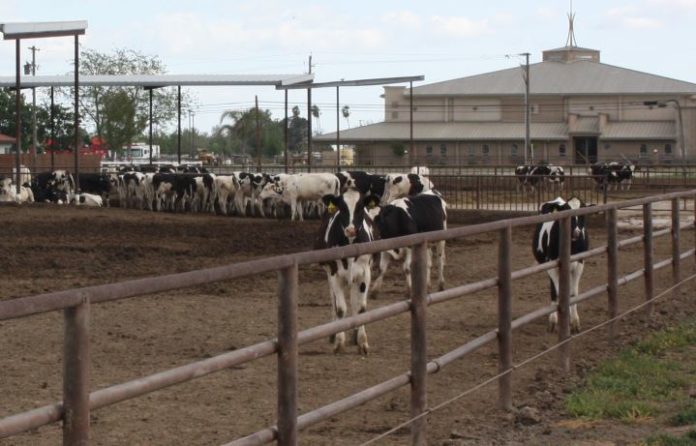 This first appeared at www.DairyCares.com
This first appeared at www.DairyCares.com
The implementation of the Sustainable Groundwater Management Act (SGMA) and other anticipated water restrictions pose major challenges for California agriculture. Without effective solutions, economists have estimated that up to one million acres of farmland will be fallowed, resulting in a revenue loss of $7.2 billion per year. As the state’s top agricultural commodity, dairy farming is an important part of the SGMA challenge. Fortunately, dairy farmers have an excellent track record for water savings and are continuing to adopt innovative strategies to advance environmental sustainability and help meet the water conservation challenges ahead.
More than 40 percent of feed ingredients used on California dairy farms are byproducts of other agricultural and food production processes. More than 40 percent of  feed ingredients used on California dairy farms are byproducts of other agricultural and food production processes.
feed ingredients used on California dairy farms are byproducts of other agricultural and food production processes.
According to researchers at University of California, Davis, the amount of water used per unit of milk produced in the state has decreased more than 88 percent over the past 50 years. This is primarily due to improved feed crop production and water use efficiency. A large portion of the water savings can be attributed to the use of byproducts as feed.
More than 40 percent of feed ingredients used on California dairy farms are byproducts of other agricultural and food production processes, which are provided as dairy feed without any additional water needed for production. This includes materials such as  almond hulls, tomato and citrus pulp, cotton seed, and brewer’s grain, which could otherwise be wasted. Dairy farmers work with nutritionists to incorporate these materials into well-balanced, nutritious rations for cows. In this way, dairy farms work in harmony with the state’s other agricultural and food production industries—making for efficient use of water resources.
almond hulls, tomato and citrus pulp, cotton seed, and brewer’s grain, which could otherwise be wasted. Dairy farmers work with nutritionists to incorporate these materials into well-balanced, nutritious rations for cows. In this way, dairy farms work in harmony with the state’s other agricultural and food production industries—making for efficient use of water resources.
While dairies typically grow the majority of their non-byproduct feed ingredients  using recycled water from the dairy, feed is also grown out-of-state, further reducing in-state water use by more than 30 percent. Over the past 50 years, California dairy farmers have also significantly increased the amount of feed crops they grow per acre of land, providing tremendous environmental benefits—reducing the amount of fertilizers, pesticides, and herbicides needed, while also reducing the energy to irrigate crops, and the amount of fuel used by tractors. Water use and feed production will remain an important topic moving forward, which is why California dairy farmers continue to implement new strategies and technologies to boost water use efficiency and promote overall sustainability.
using recycled water from the dairy, feed is also grown out-of-state, further reducing in-state water use by more than 30 percent. Over the past 50 years, California dairy farmers have also significantly increased the amount of feed crops they grow per acre of land, providing tremendous environmental benefits—reducing the amount of fertilizers, pesticides, and herbicides needed, while also reducing the energy to irrigate crops, and the amount of fuel used by tractors. Water use and feed production will remain an important topic moving forward, which is why California dairy farmers continue to implement new strategies and technologies to boost water use efficiency and promote overall sustainability.
One example of these efforts was recently awarded a prestigious sustainability award from the Innovation Center for U.S. Dairy. Sustainable Conservation and Netafim partnered with De Jager Dairy and two other California dairies to develop and demonstrate a new way to grow dairy forage crops: a subsurface drip irrigation (SDI) system that uses  manure effluent. The system delivers plant nutrients found in dairy manure beneath the soil surface, improving irrigation water use efficiency and nutrient use efficiency, while providing other environmental benefits. Thanks to this partnership effort and grant funding now being provided by the Natural Resource Conservation Service (NRCS), more dairy farms will soon be able to implement this approach.
manure effluent. The system delivers plant nutrients found in dairy manure beneath the soil surface, improving irrigation water use efficiency and nutrient use efficiency, while providing other environmental benefits. Thanks to this partnership effort and grant funding now being provided by the Natural Resource Conservation Service (NRCS), more dairy farms will soon be able to implement this approach.
The manure SDI system will serve as an important tool in the implementation of SGMA for two reasons: the conservation of water (nearly 40 percent more crop produced per drop of water) and a more efficient use of manure nutrients as fertilizer. As acres of farmland will need to be fallowed to meet SGMA requirements, dairy farmers will need to ensure manure nutrients produced on their farms continue to be used in ways that best to protect water and air quality, while helping build healthy soils. The organic matter and nutrients found in dairy manure have potential to help improve the health and water-holding capacity of soils throughout the state.
Dairies are an integral part of any sustainable food system. The state’s dairy farms play an important role—from providing nutritious dairy foods and 180,000 year-round jobs, to utilizing thousands of tons of byproducts as feed, while offering a source of organic matter that can help promote healthy, more resilient soils. California dairy farms also continue to demonstrate a commitment to sustainability—reducing water use by adopting innovative practices. Likewise, dairy farms will continue to be an important part of the conversation—as farmers, stakeholders, and officials at both the local and state level continue developing plans to achieve sustainability in groundwater use and protect the environment.
DISCLAIMER OF RESPONSIBILITY; Waterwrights.net strives to provide his clients with the most complete, up-to-date, and accurate information available. Nevertheless, Waterwrights.net does not serve as a guarantor of the accuracy or completeness of the information provided, and specifically disclaims any and all responsibility for information that is not accurate, up-to-date, or complete. Waterwrights.net’s clients therefore rely on the accuracy, completeness and timeliness of information from Waterwrights.net entirely at their own risk. The opinions expressed in this report are those of the author and do not represent any advertisers or third parties.

































